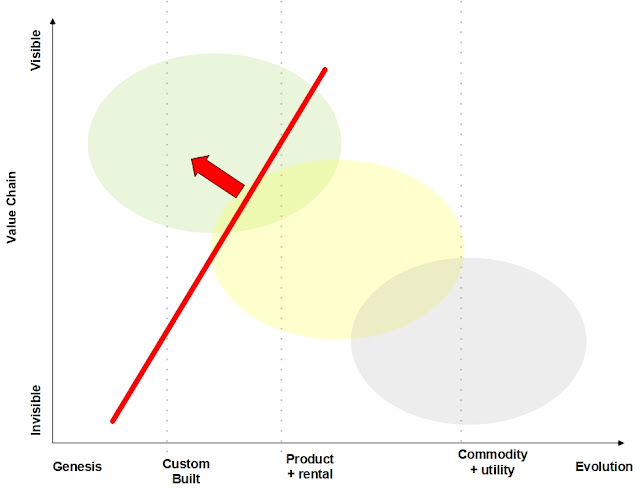It's also not thought of as an optimal technical solution for a business problem.
But, it's the only way for late majority users to adopt the new technology lifecycle. It's also the elephant in the room.
Let's start with Roger' bell curve:
Figure 1. Roger' bell curve. credit:Wikipedia.org
Conceptually, the businesses that are going to use a public cloud strategy effectively are the ones that are arguably already using it. They were the innovators, AWS, Google, Azure, etc. What's interesting, in the case of the first two, the lifecycle that lead to public cloud was an arbitrage of their excess capacity. A way to wring out more value from already in place infrastructure.
The "earlies" saw this as a starting point for their needs. Through consumption of a defined model of delivery, their use cases fit the new lifecycle model. At any relative scale, public cloud was a way to reduce the business decision of build vs consume. Netflix is an incredibly good example of an "early", using the new lifecycle model literally made it possible for them to concentrate their effort more specifically on developing their product.
The "earlies" saw this as a starting point for their needs. Through consumption of a defined model of delivery, their use cases fit the new lifecycle model. At any relative scale, public cloud was a way to reduce the business decision of build vs consume. Netflix is an incredibly good example of an "early", using the new lifecycle model literally made it possible for them to concentrate their effort more specifically on developing their product.
The late majority has a different business problem than the innovators and the "earlies."
They desperately want to be able to take advantage of the advances they perceive in the technology change:
They desperately want to be able to take advantage of the advances they perceive in the technology change:
Figure 2. Enterprise Virtualization vs Public Cloud - Link
I've previously described the state of advancement of enterprise virtualization vs @swardley 's Public Cloud map using his technique (above).
The difference under the Wardley mapped model though, is that the Use Case doesn't align cleanly.
It is also why there's a contentious argument in the minds and words of business owners.
During the peak of expectations, we hear statements like this:
"We're moving our workloads to public cloud."
"We'll be 100% public cloud in 2 years."
In despair, the story changes.
"Public cloud is too expensive."
"Public cloud is not secure."
This is also why Workload (or Cloud) Repatriation occurs.
With enlightenment, the story changes, yet again.
"We're implementing with hybrid cloud, so we can take advantage of new technologies and techniques."
Today, anyone that says they are moving from legacy to hybrid cloud is perceived as a laggard.
Today, anyone that says they are moving from legacy to hybrid cloud is perceived as a laggard.
Consider this:
When a business from the "earlies" in public cloud moves to hybrid, it is a conscious business decision. It's thought of as forward thinking.
Consider the infrastructure necessary to deliver Netflix today. It's not pure public cloud. In order to meet the content delivery goals with their customers, they built a Content Delivery Network (CDN), integrated with their platform. It is hybrid.
When the public cloud innovators and the "earlies" start to invest in on-prem workload execution, it is hybrid.
Multi-Cloud Strategy is meeting in the middle ground.
It is a legitimate tool in the #ITToolbox.
The immediate future is hybrid.
It is a legitimate tool in the #ITToolbox.
The immediate future is hybrid.








